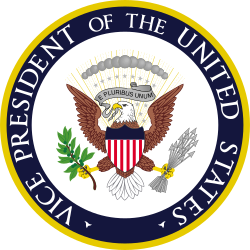Aaron Burr
| Aaron Burr | |
 | |
USA:s 3:e vicepresident | |
| Tid i befattningen 4 mars 1801–4 mars 1805 | |
| President | Thomas Jefferson |
|---|---|
| Företrädare | Thomas Jefferson |
| Efterträdare | George Clinton |
| Född | 6 februari 1756 Newark, Essex County, New Jersey, USA |
| Död | 14 september 1836 (80 år) Staten Island, New York |
| Gravplats | Princeton Cemetery[1] |
| Politiskt parti | Demokrat-Republikan |
| Yrke | Politiker |
| Maka | Theodosia Bartow Prevost |
| Namnteckning | |
Aaron Burr Jr., född 6 februari 1756 i Newark, New Jersey, död 14 september 1836 på Staten Island i New York, var en amerikansk politiker och dotterson till Jonathan Edwards, demokrat-republikan som var den 3:e vicepresidenten i USA, från 1801 till 1805. Under det amerikanska frihetskriget var han överstelöjtnant i USA:s armé. Innan han blev vicepresident under Thomas Jefferson var han distriktsåklagare i New York.
Duellen
Burrs liv tog en dramatisk vändning efter det att han i Weehawken i New Jersey 11 juli 1804 utkämpat en duell med Alexander Hamilton, vilken avled efter att ha träffats av skottet från Burrs pistol. Burr anklagades för mord, men åtal kom aldrig att väckas. Burr rannsakades för högförräderi 1807, då president Jefferson anklagade honom för att ha velat avskilja de västra delarna av USA till ett eget land (den så kallade Burr-konspirationen). Han frikändes, men fanns skyldig till att ha stämplat för att starta krig med Spanien för att erövra Mexiko.
Efter högförräderirättegången förde Burr kringflackande liv i Europa under några år, bland annat vistades han en tid i Sverige. Han kom tillbaka till USA och slutade sitt liv som advokat i New York.
Litterär gestaltning
Aaron Burr är den eponyme hjälten i Gore Vidals roman Burr 1973 (på svenska som Duellen 1975),[2] som ifrågasätter den traditionella tolkningen av Burr som mördare och förrädare.
Källor
- ^ Find a Grave, läs online, läst: 12 juli 2024.[källa från Wikidata]
- ^ Vidal, Gore (1975). Duellen. Stockholm: Norstedt. ISBN 91-1-753092-X
Externa länkar
 Wikimedia Commons har media som rör Aaron Burr.
Wikimedia Commons har media som rör Aaron Burr.- The private journal of Aaron Burr, during his residence of four years in Europe; with selections from his correspondence (1838) Burrs tryckta dagbok från tiden i Europa, bland annat i Stockholm.
- Biographical Directory of the United States Congress
- Political Graveyard
- Aaron Burrs grav på Find A Grave (engelska)
| ||||||||||
| |||||||||||||||||||||||
|
Media som används på denna webbplats
Seal of the Vice President of the United States. The blazon is defined in Executive Order 11884 as:
The design is the same as the Seal of the President of the United States, except that there is no ring of stars, the clouds are gray (instead of proper), the stars are gray (instead of argent), the scroll is gray (instead of white), the arrows are gray (instead of proper), and the background colors and inscription (obviously) differ.The Coat of Arms of the Vice President of the United States shall be of the following design:
SHIELD: Paleways of thirteen pieces argent and gules, a chief azure; upon the breast of an American eagle displayed holding in his dexter talon an olive branch proper and in his sinister a bundle of thirteen arrows gray, and in his beak a gray scroll inscribed "E PLURIBUS UNUM" sable.
CREST: Behind and above the eagle a radiating glory or, on which appears an arc of thirteen cloud puffs gray, and a constellation of thirteen mullets gray.
The Seal of the Vice President of the United States shall consist of the Coat of Arms encircled by the words "Vice President of the United States."
Signature of Aaron Burr.





